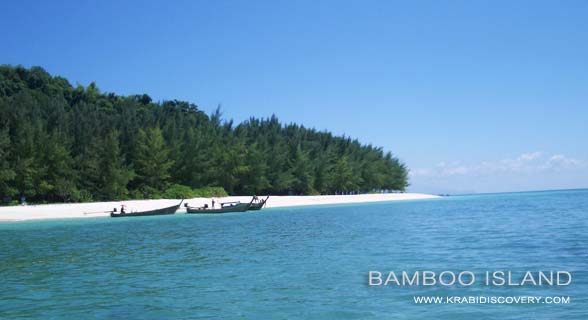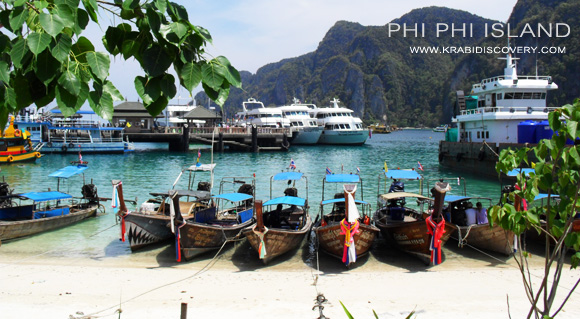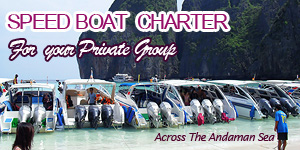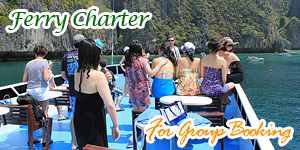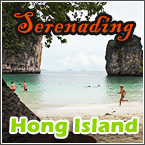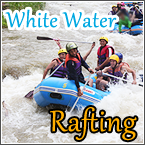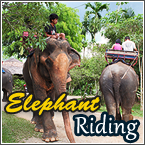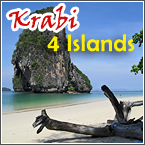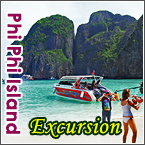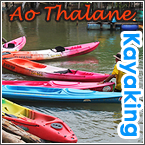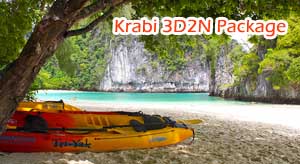Koh Phi Phi’s Group of Islands
July 5, 2009 by admin
Filed under Attractions
Phi Phi Island : The Chao Ley sea gypsies named the islands Pulaopi are pi. Pulao means island and pi is a kind of tree or samae. The island group lies 42 km from the mainland of Krabi and is composed of 6 islands : Phi Phi Don Island, Phi Phi Ley Island, Bida Nork Island, Bida Nai Island, Mosquito Island and Bamboo Island.
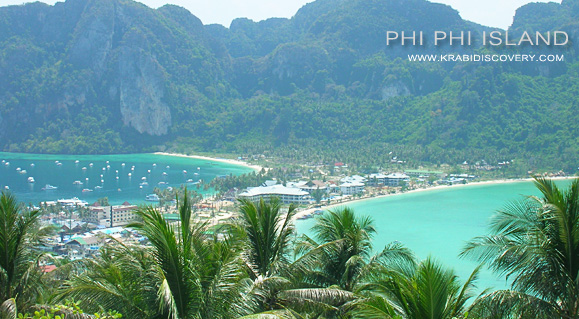
MOSQUITO ISLAND
Lies to the North of Phi Phi Don Island. It is the least visited of all the local islands, with very little beach land, but is not lacking in underwater attractions, as testified by the visits of dive operators.
BAMBOO ISLAND
Can be found not far from Mosquito Island, East of Phi Phi Don Island. It is best known for its beautiful, spacious beaches in the North and East. The area encompasses abundant coral growth, parallel to the beach in a North – South direction. Accessible only by boat, the dive site of Hin Klang lies in the open sea between Bamboo Island and Phi Phi Don Island. With a wealth of diverse coral and absolutely teeming with reef fish in the 3 -5 metres depth range, it is considered by many to be Phi Phi’s number one snorkeling reef.
PHI PHI DON ISLAND
Covering an area of 28 square km, Phi Phi Don Island is 8 km in length. In the North there is Laem Tong, presumed to be the original site of settlement, and still home to the descendants of the first settlers, the Chao Ley sea gypsies. Their ancestors are believed to have arrived here in their wooden fishing boats, having travelled from Lipe Island in the southern province of Satun. Laem Tong is also a good spot to stop for snorkelling;the other main snorkelling spots on Phi Phi Don itself being Hua Ragate, Lantee Bay, Monkey Beach and Hin Pae, just off Long Beach. The huge, twin bays visible from the often photographed beautiful Viewpoint Hill are Tonsai Bay and Loh Dalum Bay. Tonsai Bay is the deeper of the two bays. It is where Tonsai Pier is located, the point of entry and departure for most boats. Loh Dalum Bay is shallower, just as beautiful, but quieter, being used by only speed boats and longtail boats. The not-to-be-missed lookout point on top of Viewpoint Hill, 314 m above sea level, is a 1.5 km steep climb. A bird’s eye view from the top reveals the two amazing, crescent-shaped bays in all their glory. Here is one of the best places to appreciate what scope Phi Phi has for exploring by canoeing or kayaking, snorkelling or diving, and touring by speed boat or longtail boat. The vast, grand backdrop of limestone cliffs is awe-inspiring. Tonsai Tower, at one end of the main beach in Tonsai Bay, is a challenging but highly rewarding cliff face for climbers. It has both single pitch and multi-pitch routes to suit first-timers and professionals alike. Pa Hin Taek, which can only be reached by boat, is another climbing location, with 20 multi-level routes, the most popular of which is the Happy Banana route. Phi Phi Don Island has many tourist facilities, all within easy walking distance. No motorized vehicles are allowed on the land. Here there is access to every grade of hotel, bungalow or guesthouse, but reservations through travel agents prior to arrival are necessary during busy periods.
FACILITIES ON PHI PHI DON ISLAND
There are essential banking facilities, including ATMs and money exchanges, convenience stores open 24 hours, souvenir shops, market stalls serving local food, as well as bars and restaurants with competitive, high standards of international and Thai cuisine. The travel agents on Phi Phi offer boat rentals, snorkeling and kayaking trips, diving, climbing and yachting. As can be seen, with all its natural resources and supporting facilities, there is no shortage of things to do in Phi Phi, and many visitors consider it the highlight of their stay in the South of Thailand.
PHI PHI LEY ISLAND
Approximately a third of the size of Phi Phi Don Island, the sister island of Phi Phi Ley covers a total area of only 6.6 square km, and is composed mostly of sheer, steep limestone cliffs, rising from the sea, where the bottom depths are typically 18-20 metres. There is only one deep point of 34 metres, off the island’s northern point, referred to as the head of Phi Phi Ley. There are 3 bays : Maya Bay, Pi Leh Bay and Lohsamah Bay meet in a thin neck of land at the South of the island.
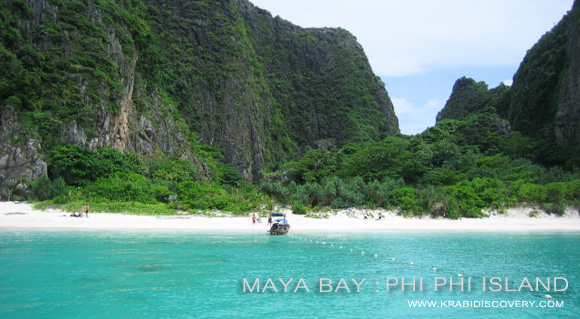
VIKING CAVE
In the North-East of the island is typically the first stop of an island tour. The cave is a few metres above sea level, and accessed by a small jetty for boats. The two things that Viking Cave is famous for are the birds’ nests collected for birds’ nest coup and some fascinating ancient cave paintings. Apart from a few interesting rock formations, including stalagmites and stalactites, visitors will discover inside the cave some crude bamboo canes tied together with ropes and vines, extending up into the lofty, pitch black height of the cave. On the eastern and southern wall of the cave, they are several ancient paintings of European and Arab sailing boats, a junk and steamer. They are presumed to be the work of sailors or pirates who stopped along the route to take shelter from the wind and waves of the monsoon, hide some treasure or carry out boat repairs.
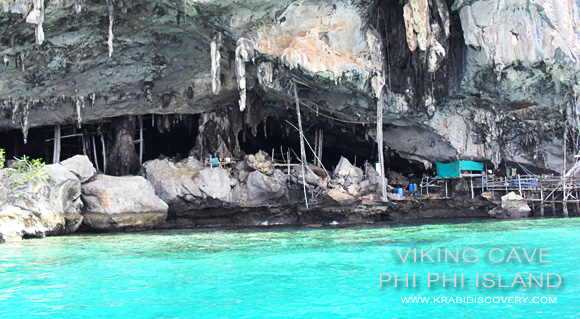
PI LEH BAY
Pileh Bay is a hong (room) or sea lagoon, an area of water almost almost entirely enclosed by high cliffs. It lies a little further South of Viking Cave. The entrance to the bay is a channel of clear water with shallow corals and reef fish, an excellent place to explore by snorkelling or kayaking. On the right hand side as you enter, is a small beach and a sheer cliff face with at least 7 routes for rock climbers, the most interesting of which is called “Four Beers of Singha”.
LOHSAMAH BAY
Lohsamah Bay is to be found at the furthest end of Phi Phi Ley in the South. It too has excellent snorkeling and diving opportunities, suitable for all levels of experience. There are the added bonuses of a quiet, sandy beach and a very attractive walking trail to Maya Bay. The starting point for this trail from Lohsamah Bay is a stony gateway – a short tunnel-accessible only by boat, and flooded at high tide.
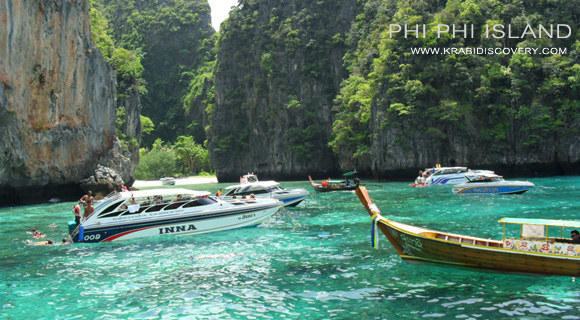
MAYA BAY
is the largest and finest bay of the island; many would agree it is the crowning glory of Phi Phi Ley. It lies on the West coast. The main beach is pure white and crescent-shaped. Towering limestone walls all round block the waves perfectly, and the atmosphere in this wonderful beauty spot is unique. Throughout the high season from November to April, Maya Bay attracts day trippers from all over, who come to enjoy sunbathing, swimming, snorkeling, kayaking, photography and relaxing in the most exotic of natural surroundings. It is much quiter during the low season months of May until October, when sea conditions frequently make access to the bay inconvenient or unpractical for boats. Filmed as part of Hollywood’s controversial movie ‘The Beach’ starring Leonado di Caprio, Maya Bay’s fame has by now spread to all four corners of the world.
THE BIDA ISLANDS
Further South of Phi Phi Ley, facing Lohsamah Bay, lie the two islands of Bida Nork and Bida Nai. As you approach them from the direction of Phuket, their shapes resemble a pair of army boots. These two small, rocky islands have no beach, but they do have fabulous coral gardens and reefs, which are best explored by scuba diving.
HOW TO GET TO THE PHI PHI ISLANDS
These days Phi Phi can easily be reached by boats from Krabi town, Ao Nang, Phuket or Koh Lanta, with many regular services. The fastest transfer is by speed boat from Krabi town or Ao Nang; journey time being typically 45 minutes. Otherwise the larger, more common boats need at least one and a half hours to complete the same trip in good sea conditions, and two to two and a half hours when the sea is rough. Leading tour operators runs regular trips to Phi Phi from Krabi and Ao Nang, with a choice of various packages to suit every one’s needs
Source : Krabi Tourism Association

